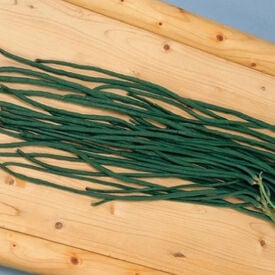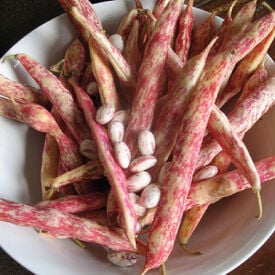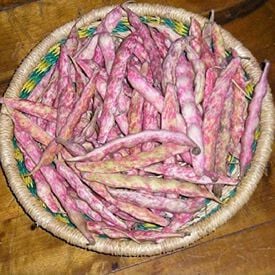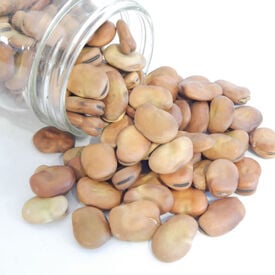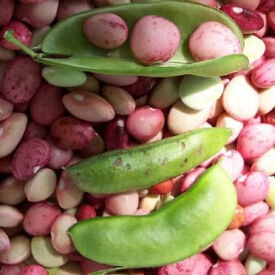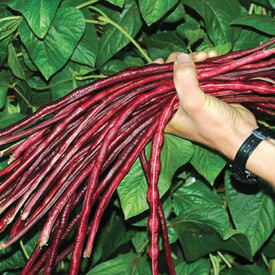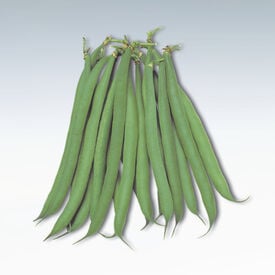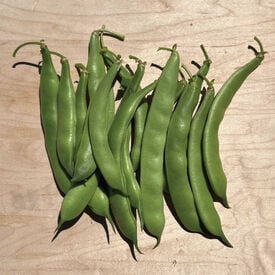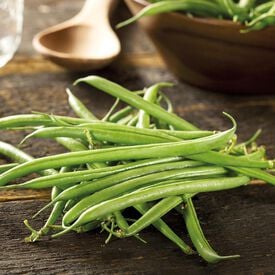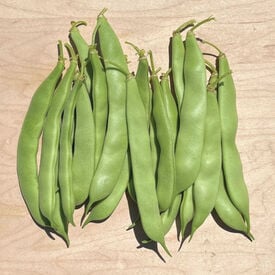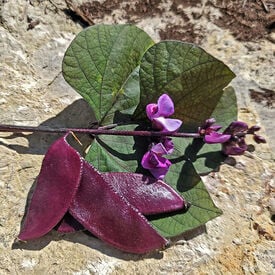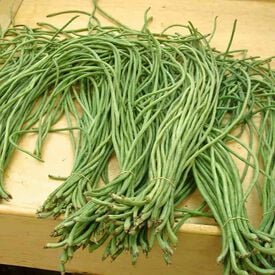Learn More
The Orient Wonder bean is a white seeded yard-long bean with tender pods. This type of pole bean is sometimes called asparagus or yard-long bean. Popular in warm and humid areas, where plants are vigorously vining. Extra-long, slender pods are slow to form seeds, resulting in more tender beans that can be harvested over an extended period. Orient Wonder is popular for specialty and ethnic markets and superior to standard strains due to its ability to set in cooler climates.
The Vermont Cranberry Shell bean is an incredible bean variety that can be used as a snap, shell or dry bean. Cranberry Shell stores exceptionally well. Maroon colored beans are decorated with darker red, cranberry markings. This variety dates back to the 1800s and is well-suited to short-season, cool summer climates.
Greencrop beans are a classic heirloom variety renowned for their distinctive features and reliable performance. Originating in the early 20th century, this variety has been favored by gardeners for its robust growth and high productivity. Greencrop beans are characterized by their striking green color, smooth texture, and uniform shape. The plants are typically bush-type, reaching a height of about 18 to 24 inches, which makes them suitable for smaller garden spaces and easier to manage without extensive staking. The beans themselves are known for their crisp and tender texture, combined with a mildly sweet and fresh flavor that enhances a variety of dishes. Harvesting is best done when the pods are young and firm, usually in mid to late summer, to ensure optimal taste and texture. Greencrop beans are valued for their high yield and resistance to common diseases, making them a dependable choice for both home gardeners and market growers. With their appealing flavor, compact growth habit, and consistent performance, Greencrop beans remain a popular and practical selection for vegetable gardens.
Amarillo beans (Frijol Amarillo) are a beloved heirloom variety in Mexican cuisine, known for their golden-yellow color and slightly sweet, earthy flavor. These beans are medium-sized, with a smooth texture that makes them perfect for use in a variety of traditional dishes, such as stews, soups, and frijoles de la olla. Their subtle flavor and creamy consistency when cooked make them a versatile ingredient in both savory and vegetarian meals. Grown primarily in the central and southern regions of Mexico, Amarillo beans are well-suited to a range of climates and soil types, offering resilience and a reliable yield. As an open-pollinated variety, they are ideal for sustainable farming practices and seed-saving, ensuring that this flavorful and nutritious bean continues to play an essential role in both Mexican agriculture and cuisine.
The French horticultural shell bean, also known as "Haricot Tarbais," is a classic heirloom variety renowned for its exceptional flavor and versatility in culinary applications. Originating in the Tarbes region of France, this bean has a rich historical significance in French cuisine. Its taste profile is a harmonious blend of nutty, earthy, and slightly sweet notes, making it a sought-after choice for gourmet dishes. This bean is classified as a pole bean, meaning it grows as a climbing vine that requires support. The pods of the French horticultural shell bean are medium-sized, typically reaching 4-6 inches in length, and they display a stunning mottled appearance with a creamy background and reddish streaks. The plant itself can attain a height of 8-10 feet, and it generally takes around 70-80 days to reach maturity from planting. In terms of disease resistance, the French horticultural shell bean exhibits decent resistance to common bean diseases like rust and mildew, although it's advisable to monitor and manage pests as needed. Under ideal growing conditions, this variety can yield approximately 1500-2000 pounds of beans per acre. Proper spacing is crucial for optimal growth; ensure that plants are spaced about 6-8 inches apart in rows that are 2-3 feet apart. These beans thrive in well-drained soil with full sun exposure and benefit from regular watering to maintain consistent moisture levels throughout the growing season. With its outstanding flavor and culinary versatility, the French horticultural shell bean is a delightful addition to any garden or kitchen.
Fava Broad Windsor beans, also known as Vicia faba 'Broad Windsor,' are a classic heirloom variety with a storied history and a range of notable characteristics. Originating in the United Kingdom, this variety has been cultivated for centuries and is particularly valued for its large, hearty beans and reliable yield. The plants are characterized by their robust growth habit, reaching heights of 24 to 36 inches, with broad, dark green leaves and striking white flowers often tinged with purple. The beans themselves are large and plump, typically encased in thick, protective pods that turn from green to a rich brown as they mature. Fava Broad Windsor beans are known for their creamy, slightly nutty flavor, which becomes more pronounced when the beans are cooked. The plants generally bloom in late spring to early summer, and the beans are usually harvested about 80 to 90 days after sowing. They thrive in cool, well-drained soil and prefer full sun to partial shade. The robust nature of the plants and their ability to fix nitrogen in the soil make them a valuable crop for improving soil fertility in rotation systems. With their rich flavor, historical significance, and agronomic benefits, Fava Broad Windsor beans are a cherished choice for both traditional and modern gardens.
Jackson Wonder bush lima beans are a treasured heirloom variety with deep roots in Southern agriculture, particularly celebrated in the early 20th century. Known for their compact, bush-type growth habit, these beans typically reach heights of 18 to 24 inches, making them ideal for small gardens and easy to manage without support. The beans are characterized by their creamy white color, often with subtle greenish hues, and they grow in smooth, straight pods. Renowned for their rich, buttery flavor and creamy texture, Jackson Wonder beans are perfect for soups, stews, and as a delightful side dish. Harvesting typically occurs in mid to late summer when the pods are plump and the beans are fully developed but still tender. These plants are vigorous and produce a high yield, thriving in well-drained soil with ample sunlight, while also exhibiting resilience against common pests and diseases. With their delicious taste and reliable productivity, Jackson Wonder bush lima beans remain a favorite among gardeners and culinary enthusiasts alike.
Christmas bean, scientifically known as Phaseolus vulgaris 'Christmas,' is a delightful and unique variety of green bean that adds a festive touch to holiday meals. This particular bean cultivar has a fascinating history dating back to the early 20th century when it was first developed by dedicated plant breeders. Its name, "Christmas bean," is derived from its vibrant red and green coloration, reminiscent of traditional holiday colors. In terms of taste, Christmas beans are known for their tender and crisp texture, making them a delightful addition to a variety of dishes. Their flavor is mildly sweet with a subtle nuttiness, making them a versatile choice for both cooking and salads. The beans typically mature in about 80 to 90 days, making them a relatively quick-growing option for gardeners. The pod size is medium to large, with an average length of 6-7 inches, perfect for harvesting when they are young and tender. Christmas bean plants need staked and can grow up 10' and higher! They are known for their disease resistance, particularly against common bean diseases such as rust and bean mosaic virus. When properly cared for, Christmas bean plants can yield an abundant harvest, with each plant producing a substantial number of pods. For optimal growth, they require well-drained soil, full sun exposure, and regular watering. Plant spacing should be about 4-6 inches apart in rows, and they thrive in a variety of climates, making them a popular choice for gardeners looking to add a festive touch to their holiday season while enjoying a bountiful harvest of delicious, colorful beans.
Asparagus Red Podded beans are a unique and vibrant variety of snap beans known for their striking appearance and delicious flavor. Characterized by their deep red pods, these beans stand out in the garden and on the plate. They grow well in warm climates and can be harvested when young and tender for a delightful crunch in salads or stir-fries. In addition to their eye-catching color, they are rich in nutrients, providing a good source of vitamins A and C, fiber, and protein. The beans are not only visually appealing but also offer a sweet, earthy taste that complements a variety of dishes, making them a favorite among home gardeners and chefs alike.
A gourmet, dwarf French filet bean well suited for container gardens or rows. Cooks appreciate the elegance of these petite, slim beans of consistent quality. Considered one of the best flavored beans that stay tender for several days after harvest. Suitable for small space gardens.
Dulcina is a bush type, flat, Italian bean. This high yielding Romano bean with its upright vine habit and concentrated pod set make it well suited for both mechanical and hand harvesting.
A skinny filet bean with straight and smooth pods. Offers excellent flavor for home gardens and market growers. 5-6" pods that are resistant to anthracnose and bean mosaic virus.
The Taylor Dwarf Horticulture Bean, also known as the Taylor Horticulture Bean or simply Taylor Dwarf Bean, is a popular heirloom bean variety prized for its delicious flavor and historical significance. This bean variety has a rich history dating back to the early 19th century in the United States. It is a bush-type bean, which means it grows in a compact, bushy form rather than climbing like pole beans. Taylor Dwarf Horticulture Beans are highly regarded for their superb taste, which is characterized by a creamy texture and a slightly nutty, earthy flavor. The beans are typically harvested when they are young and tender, making them ideal for fresh consumption or canning. The pods of the Taylor Dwarf Horticulture Bean are medium-sized and typically measure around 4-5 inches in length. The plants themselves are relatively small and bushy, reaching a height of about 18-24 inches, which makes them suitable for smaller gardens or container gardening. This variety has a relatively short maturity period, typically taking around 55-60 days from planting to harvest. The beans themselves are a pale cream or off-white color. Taylor Dwarf Horticulture Beans are known for their good disease resistance, which helps ensure a healthy crop. In terms of yield, you can expect a respectable harvest of beans per row, with each plant producing multiple pods. Proper spacing between plants should be around 4-6 inches apart in rows that are spaced about 18-24 inches apart. These beans thrive in well-drained soil with good organic matter content and prefer full sun for optimal growth. Adequate moisture and regular harvesting will help ensure a bountiful crop of these delicious and historically significant beans.
Chivo Blanco beans (Frijol Chivo Blanco) are a cherished heirloom variety native to Mexico, known for their small, white, and slightly oval-shaped beans. These beans are valued for their creamy texture and delicate flavor, making them perfect for a wide range of traditional Mexican dishes such as soups, stews, and frijoles de la olla (beans in a pot). The name "Chivo Blanco" refers to their smooth, pale appearance, and they are often praised for their ability to cook quickly and absorb seasonings well. Grown primarily in the central and southern regions of Mexico, Chivo Blanco beans are resilient to various growing conditions, thriving in both temperate and semi-arid climates. As an open-pollinated variety, they are ideal for sustainable farming and seed-saving, helping to preserve the rich agricultural heritage of Mexico while offering a reliable, nutritious source of protein for many households.
The Hidatsa Shield bean, an heirloom variety with deep cultural roots, traces its origins to the Hidatsa people of the northern Great Plains in the United States. This ancient cultivar was cherished for its hardiness and flavor, embodying a vital part of the Hidatsa diet for centuries. The bean is named for its distinctive shield-shaped markings, which can range from mottled browns and reds to purples, giving it a striking appearance. Its flavor profile is noted for a rich, nutty taste with a creamy texture, making it a favored choice in various traditional dishes. The plant itself is a vigorous climber, known for its adaptability to different soil types and growing conditions. It typically blooms in mid-summer, producing small, pale flowers before setting pods that are ready for harvest in late summer or early fall. The Hidatsa Shield bean's resilience and ease of cultivation, coupled with its historical significance, continue to make it a valued crop among gardeners and food enthusiasts.
Ruby Moon Hyacinth Bean, also known as Lablab purpureus or simply Hyacinth Bean, is a unique and versatile legume known for its vibrant appearance and culinary potential. This heirloom variety is named for its striking ruby-red pods and dark green foliage, making it an attractive addition to both ornamental and edible gardens. Ruby Moon Hyacinth Beans are typically grown as annuals, but in tropical regions, they can be perennial. In terms of taste, the young pods and seeds of Ruby Moon Hyacinth Bean are edible and have a mild, nutty flavor similar to green beans. They can be consumed both raw and cooked. However, it's important to note that mature seeds contain toxic compounds and should not be eaten without proper processing. Ruby Moon Hyacinth Beans have a rich history, with their cultivation dating back centuries, primarily in Asia and Africa. They are valued not only for their culinary uses but also for their ability to fix nitrogen in the soil, enhancing soil fertility. This plant is categorized as a warm-season annual and typically matures in about 60-90 days, depending on growing conditions. The size of the Ruby Moon Hyacinth Bean plant can vary, but it generally reaches a height of 6-10 feet, making it suitable for trellises or fences. When it comes to yield, you can expect approximately 10-15 pounds of pods per plant or around 800-1,200 pounds per acre under ideal conditions. These beans thrive in full sun and well-drained soil, and they require a warm climate to grow successfully. Adequate moisture and support for climbing are essential for a bountiful harvest. With proper care, Ruby Moon Hyacinth Beans can be a delightful addition to your garden, offering both visual appeal and a tasty, nutritious addition to your plate.
A beautifully bright and vibrant green bean that grows extra long when mature! Matures quick and has a delicious and crisp bite.
Bayo beans (Frijol Bayo) are a popular heirloom variety in Mexican cuisine, known for their creamy texture and mild, earthy flavor. These small, tan-colored beans with subtle speckling are prized for their versatility, often used in a variety of dishes like soups, stews, and refried beans. Their smooth consistency when cooked makes them ideal for creating hearty, comforting meals, and they hold up well in both traditional Mexican fare and more contemporary recipes. Bayo beans thrive in warm climates with well-drained soil and are particularly appreciated for their drought tolerance and resilience in the field. As an open-pollinated variety, Bayo beans are excellent for sustainable farming practices and seed-saving, allowing farmers and gardeners to preserve this rich agricultural tradition. These beans are not only a staple in many homes but also an essential part of Mexico’s agricultural and culinary heritage.
